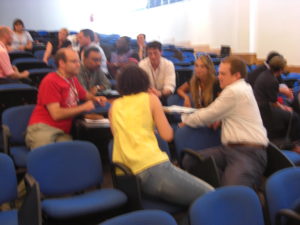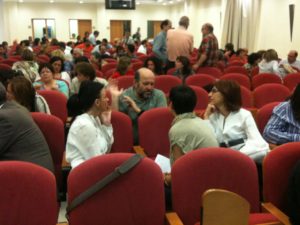In most talks or seminars, the audience is not allowed to discuss the presentation. This doesn’t have to be the case. Allotting a few minutes during the Q&A session for conversation can facilitate this.
Conferences far too often rely heavily on standard lecture-style talks in which presenters speak and attendees passively listen. However, integrating genuine dialogue and audience participation into presentations is critical for more impactful and engaging talks and conferences.
When attendees are given opportunities to discuss ideas and questions in small groups, talks come to life and become vibrant conversations. Thoughtful back-and-forth dialogue allows attendees to grapple honestly with concepts, share perspectives, and gain deeper insight.
In contrast, scripted Q&A sessions generate less organic and meaningful exchanges. By restructuring conference talks to incorporate intentional and facilitated conversations, presenters can spark richer peer-to-peer interactions that stick with participants long after the event.
When audiences are invited to converse, talks become more participatory, relevant, and rewarding experiences for all.
How to Structure a Talk
Let’s say you have 40 minutes for your talk; divide it roughly like this:

- Your presentation/talk, say 20 minutes.
- Pose a question – it could be “What did you make of my talk?” or it could be more specific and related to some aspect of your speech.
- Tell the audience you will give them ten minutes to discuss your question before taking questions.
- Tell them to turn to each other in 2s, 3s, or 4s (no more) and have the conversation.
- This will work even in a lecture theater (see the videos below)
- If the audience is sitting at large conference tables (typical), say 6 – 8 people per table – tell them not to hold a table conversation but to break into smaller groups – that 3 or 4 people per group is essential to allow everyone to engage in the conversation entirely.

Conversation in a lecture theatre in Barcelona - Give them 10 minutes to have the conversation (maybe a little less if they seem to lose energy or don’t take to it (in some cultures/situations, they don’t).
- Make a conversation round (not three like a regular Knowledge Café – there is rarely enough time).
- After the ten minutes, stop the conversation and take Q&A for another ten minutes.
- If your actual talk runs a little over time, just cut back a little on the time you give for conversation or Q&A – if anything, reduce or eliminate the Q&A time – it is the least valuable part – not the conversation time.
If all the speakers give conversational talks, you have a conversational conference.
And one final point: if you give your talk on Zoom or Teams, pop people in break-out rooms in groups of 3 or 4 for a few minutes.
Some Conference Conversations
I have made some short video clips and recordings of past conferences where I asked the audience members to turn and converse with each other. The videos show that this engagement exercise worked effectively even in a tiered lecture hall setting.
The audible noise level and hubbub in the rooms indicate the high level of engagement and participation among the attendees when they conversed with their neighbors.
These videos show how well a simple exercise of having attendees talk to each other can facilitate engagement and interactivity, even in a large conference environment.
First and foremost, the human brain is not designed to passively process large amounts of information for extended periods. Cognitive load theory suggests that our working memory has limited capacity. It can only hold a few pieces of information at any time, and excessive information can lead to overload. This means that during prolonged, uninterrupted lectures, students are likely to reach a point where they can no longer effectively absorb or process new information. Consequently, the latter portions of the information presented are often lost, rendering much of the lecture ineffective.
Secondly, engagement is crucial for effective learning. A key component of engagement is the opportunity for learners to interact with the material, the instructor, and their peers. This interaction can take many forms, including asking questions, participating in discussions, and applying concepts through problem-solving activities. These activities break up the monotony of a lecture and allow students to process and apply what they have learned in real-time. In contrast, sitting passively for hours on end typically results in diminished attention and engagement, leading to a passive form of learning where students are merely trying to memorize information without truly understanding it.
Furthermore, active learning is widely recognized as a more effective instruction method than passive listening. Active learning involves students in the process of learning through activities and discussions in class, as opposed to passively receiving information from the instructor. This approach has been shown to improve critical thinking skills, retention of information, and overall understanding of the subject matter. By sitting through back-to-back lectures with no opportunity for active engagement, students are denied the benefits of this more effective learning approach.
The strategy of having students sit through a series of lectures back-to-back, without breaks for questions or conversation, is fundamentally flawed. It overlooks the limitations of human cognitive processing, fails to engage students actively, and misses the opportunity to employ more effective active learning strategies. For these reasons, educational approaches should prioritize interactive, engaging, and student-centered learning experiences over traditional lecture marathons.
One of the benefits of incorporating a conversational aspect into a talk is that it requires no additional time. As a speaker, you do not need prior approval from the conference organizer or chairperson. However, it is still advisable to inform them of your plans beforehand.
Resources
- Article: Switching from Presentation Mode to Conversation Mode by Robert Kienzle
Posts that link to this post
- Conversation Sharpens the Saw It is not a waste of time
POST NAVIGATION
CHAPTER NAVIGATION
Tags: academia (8) | conferences (9) | conversational talk (6) | lecture (11) | lecture theatre (3) | presentation (1)
SEARCH
Blook SearchGoogle Web Search
Photo Credits: David Gurteen (CCY BY)
The Gurteen Knowledge Letter is a free monthly newsletter with over 20,000 subscribers that I have been publishing by email for over 20 years.
Learn more about the newsletter and register here.

